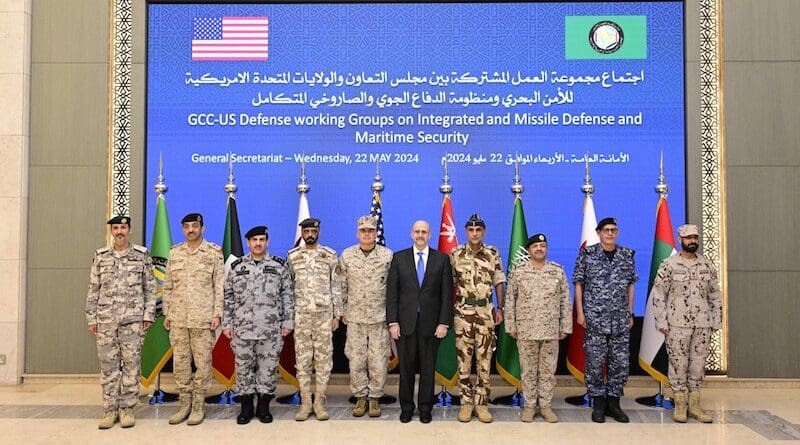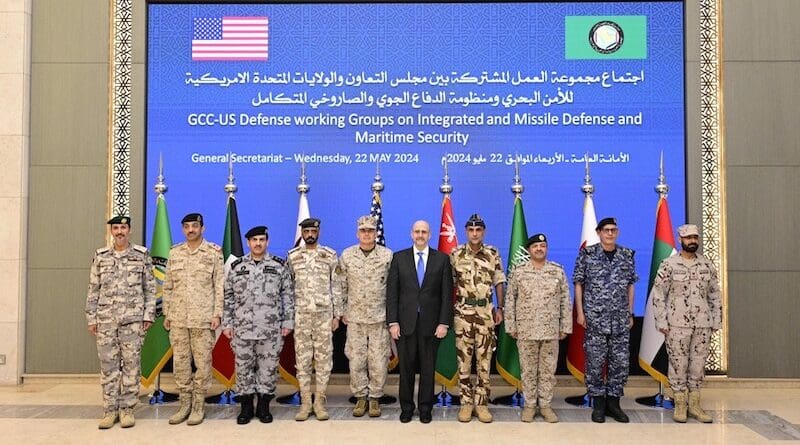

Meeting of US-GCC Defense Working Groups in Riyadh, Saudi Arabia. Photo Credit: DOD
In recent times, the collaboration between the United States and the Gulf Cooperation Council (GCC) states in defense matters has entered a critical phase, driven by the pressing need to address escalating security threats in the region. This upsurge in cooperation, echoed by Dan Shapiro, Deputy Assistant Secretary of Defense for Middle East policy, concerning the pervasive dangers stemming from Iran and its proxies, underscores a shared recognition among Gulf nations of the urgent imperative for collective action.
“The US-GCC defense working groups are rooted in a strong US partnership with the GCC and our collective commitment to cooperating on regional security issues,” said Shapiro. He previously served as US Ambassador to Israel and Abraham Accords envoy and warned that “the threats from Iran and its proxies are pervasive” in the region.
The triggering event for this intensified collaboration was the April 13 Iranian attack on Israel, a stark wake-up call to the volatile environment engulfing the Middle East. This incident catalyzed a reevaluation of defense capabilities and reignited a commitment to deeper integration among regional partners. Shapiro’s assertion that the attack acted as a catalyst for enhanced cooperation on integrated air and missile defense underscores the transformative power of shared security challenges in fostering unity among allies.
The multifaceted nature of contemporary threats demands a comprehensive approach to defense cooperation. Dialogues between US and Gulf officials on bolstering information sharing and counter-proliferation efforts exemplify this necessity, reflecting a shared understanding of the intricacies of the security landscape. By enhancing coordination in intercepting illegal maritime shipments to groups like the Houthis, the parties aim to disrupt destabilizing activities and safeguard vital sea lanes, thereby protecting shared interests.
Furthermore, proposals for joint military training highlight the importance of interoperability and shared operational frameworks. In an era defined by asymmetric threats and hybrid warfare, synchronized responses and effective communication are paramount. Building a common operational language not only enhances tactical effectiveness but also fosters a sense of camaraderie among allied forces, crucial for ensuring the success of defense endeavors.
Relations of U.S. with Gulf States: An Historical Analysis
The relationship between the United States and the Gulf states has evolved significantly over the course of history, shaped by a complex interplay of geopolitical, economic, and security interests:
- Early Engagement (19th Century – World War II):
In the 19th century, American merchants began trading with the Gulf region, primarily in pearls, dates, and textiles. However, formal diplomatic relations were limited. During World War II, the United States established strategic ties with some Gulf States, particularly Saudi Arabia, as part of efforts to secure access to oil resources and counter Axis powers’ influence in the region.
- Cold War Era (1950s – 1980s):
The Cold War era witnessed a deepening of US engagement with the Gulf States, driven by concerns over Soviet expansionism and the need to ensure stability in the oil-rich region. The Eisenhower Doctrine of 1957 pledged US support for Middle Eastern countries threatened by communism, laying the groundwork for increased military and security cooperation. The discovery of oil in the Gulf States further solidified their importance to US strategic interests, leading to the establishment of military bases and security agreements, such as the US-Bahrain Defense Cooperation Agreement of 1971.
- Gulf War and Post-Cold War Era (1990s):
The Gulf War of 1990-1991 marked a turning point in US-Gulf relations, as the United States led a coalition to expel Iraqi forces from Kuwait. This military intervention solidified US security commitments to Gulf States and underscored their dependence on US protection. The aftermath of the Gulf War saw increased US military presence in the region, including the establishment of permanent military bases in countries like Qatar and Bahrain. Economic ties also deepened during this period, with the Gulf States emerging as major investors in the US economy, particularly in sectors such as finance, real estate, and technology.
- Post-9/11 and War on Terror (2000s):
The 9/11 attacks and subsequent US-led wars in Afghanistan and Iraq reshaped US-Gulf relations, leading to increased security cooperation in counterterrorism efforts and regional stability. Gulf States provided logistical support and intelligence sharing in the War on Terror, while the United States expanded military presence in the region to combat terrorism and protect vital energy infrastructure. However, the US invasion of Iraq in 2003 and its aftermath strained relations with some Gulf States, particularly Saudi Arabia, which viewed the intervention as destabilizing and empowering Iran.
- Arab Spring and Regional Unrest (2010s):
The Arab Spring uprisings of 2011 brought about significant challenges and opportunities for US-Gulf relations. While the United States initially supported pro-democracy movements, it later aligned with Gulf States in restoring stability and countering Islamist groups. The Iran nuclear deal negotiations in 2015 further complicated relations, with Gulf States expressing concerns over perceived US concessions to Iran. This led to increased arms sales and military cooperation between the United States and Gulf states to counter Iran’s regional influence. Human rights issues, including the Saudi-led military intervention in Yemen and crackdowns on dissent, strained relations between the United States and some Gulf States, leading to tensions and criticisms from US lawmakers and human rights organizations.
- Current Dynamics (2020s):
In recent years, US-Gulf relations have been shaped by evolving security threats, including Iran’s destabilizing activities, terrorism, and maritime security challenges. The Abraham Accords in 2020, which normalized relations between Israel and several Gulf states, marked a significant development in regional geopolitics, with the United States playing a facilitating role. Economic diversification efforts in the Gulf States, coupled with shifts in global energy markets and climate change concerns, have prompted discussions on new areas of cooperation, such as renewable energy, technology, and trade diversification.
U.S. Military Presence in the Gulf
When examining the evolution of US-Gulf relations, it’s crucial to first delve into the military agreements and current military presence in the Gulf States. The United States maintains an interconnected military and strategic alliance with both individual Gulf countries and the Gulf Cooperation Council (GCC) as a whole due to its vested interest in the region’s security. Despite the Gulf States’ efforts to develop their own military capabilities for greater autonomy in handling conflicts in the Middle East, the US remains a major power broker. Notably, the US has established several vitally important military facilities in GCC countries.
One of the key facilities is the US Navy’s 5th Fleet headquarters in Manama, Bahrain, which serves as a crucial hub for maritime operations in the region. Additionally, the United States Central Command (CENTCOM) command facility is located in Qatar, underscoring the strategic importance of Gulf States in US military operations in the Middle East. Beyond these, there are numerous other facilities and military bases dispersed throughout the GCC countries, collectively hosting around 35,000 US military forces and personnel as of 2015.
These military forces and personnel are deployed in GCC countries through various Defense Cooperation Agreements (DCAs) and other strategic military agreements. Former Secretary of Defense Chuck Hagel highlighted the US’s commitment to the region during the Manama Dialogue in Bahrain in December 2013. He emphasized the US’s role in ensuring freedom of navigation in the Gulf, indicating the country’s vested interest in regional security.
Moreover, Secretary Hagel discussed the US’s ongoing investments in military facilities in the Gulf, including a $580 million construction project aimed at expanding the US Navy’s Fifth Fleet capabilities in Bahrain. This policy underscores the evolving commitment of the US to the region’s security and stability.
Each of the six GCC countries maintains some form of military agreement or strategic ties with the United States. While Saudi Arabia lacks a formal Defense Cooperation Agreement, it hosts US military assets used for training its National Guard and Ministry of Interior forces. Similarly, Qatar, which has had a Defense Cooperation Agreement with the US since 1992, predominantly hosts US Air Force personnel due to the presence of CENTCOM.
Kuwait, with a Defense Cooperation Agreement since 1991, hosts a significant number of US military personnel, primarily from the Army, at various bases. Similarly, the United Arab Emirates (UAE), which signed a Defense Cooperation Agreement in 1994, hosts around 5,000 US military members, with the Al Dhafra Air Base serving as a major facility for surveillance and refueling operations.
Bahrain, with a Defense Cooperation Agreement since 1991, hosts around 6,000 US military service members, primarily from the Navy, at the Naval Support Activity Facility. Although Oman lacks a formal Defense Cooperation Agreement, it maintains a “facilities access agreement” with the US, granting access to Omani military facilities.
In addition to bilateral engagements, the US conducts joint military exercises with the GCC states. The Eagle Resolve exercise, a major multinational exercise in the Gulf region since 1999, exemplifies this collaboration. The exercise aims to ensure regional stability and involves participation from GCC states as well as other countries.
However, amidst the promising prospects of security cooperation, economic partnership, and diplomatic engagement, significant challenges loom large for Gulf States embarking on this journey of strengthened defense cooperation:
- Geopolitical Complexities: Gulf States find themselves navigating a labyrinth of geopolitical dynamics characterized by rivalries, alliances, and competing interests. Striking a delicate balance in relations with the United States, Iran, and other regional actors necessitates diplomatic finesse and strategic expertise to avoid being ensnared in protracted conflicts.
- Internal Dynamics: Domestic political considerations and societal pressures exert considerable influence on Gulf States’ engagement in defense cooperation initiatives. Garnering support from key stakeholders and addressing public concerns regarding sovereignty, military expenditure, and foreign intervention are indispensable for fostering sustained collaboration.
- Economic Dependency: Heavy reliance on defense partnerships with the United States carries the risk of exacerbating economic dependency and undermining long-term sustainability. Gulf States must diversify their economies, invest in human capital, and foster innovation to mitigate the risks associated with overreliance on defense spending.
- Regional Instability: The volatile security environment in the Middle East poses a persistent threat to Gulf States’ security and stability. Escalating conflicts, proxy wars, and transnational terrorism have the potential to undermine efforts to strengthen defense cooperation and disrupt socioeconomic development agendas.
While the prospects for enhanced defense cooperation between the US and GCC States appear promising, navigating the associated challenges demands meticulous attention and strategic foresight. By addressing internal dynamics, managing external pressures, and fostering resilience, Gulf nations can seize the opportunities presented by strengthened defense cooperation to promote regional stability and security in the Middle East.